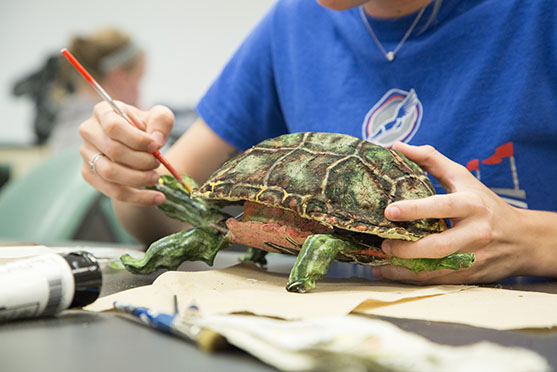Elizabethtown College art and ecology students collaborated on an interdisciplinary art project involving the algae and duckweed from the College’s Lake Placida. Now, their work is on display at the Science, Technology, Engineering, Art and Mathematics (STEAM) Gallery in the North Museum of Nature and Science in Lancaster.
 In the fall of 2016, students led by David Bowne, associate professor of biology, and Kristi Arnold, associate professor of art, created environmentally friendly paper by using algae and duckweed from the lake. The students made art from the paper, and their finished works were displayed in the Lyet Gallery in the Masters Center on campus.
In the fall of 2016, students led by David Bowne, associate professor of biology, and Kristi Arnold, associate professor of art, created environmentally friendly paper by using algae and duckweed from the lake. The students made art from the paper, and their finished works were displayed in the Lyet Gallery in the Masters Center on campus.
Bowne and Arnold ran the project again in the fall of 2017 with the same classes, but had the students in both bind a notebook with the algae paper. Then, they were asked to draw nature-based observations in their notebooks. In the spring of 2018, Arnold was on sabbatical, so Bowne had just his ecology class make the paper again. This time, he allowed the students complete freedom to make art pieces using the algae paper.
Maria Anderson, ‘18, is an E-town alum who majored in art education, and she worked with Bowne and Arnold through the Scholarship, Creative Arts and Research Projects (SCARP) program in the summer of 2017. During this time, she refined the papermaking process and ended up making two 3D turtles from her algae paper. Her work, along with representative work from all of the students who participated in this project, will be on display in the STEAM Art Gallery from its official opening Oct. 5 through the end of December.
In her SCARP reflection, Anderson said her goals for her project “were to experiment with different ratios of raw materials to evaluate the structural properties of the paper, as well as to create an artwork using the paper.”
She began her work by experimenting with various ratios of algae to cotton linter, which is a pulp using the fine, silky fibers from the cotton plant. Anderson also tested making the paper with the algae crushed as well as uncrushed. After this, she introduced duckweed from the lake to her pulp, too, to see how it would affect the mixture and the structure of the dry paper.
After the completion of the papermaking, Anderson created two sculptures of painted turtles, which live in Lake Placida. With the first one, she used a paper mache technique “to evaluate the structural integrity of the paper when it was wet,” she noted in her reflection. While creating her second sculpture, Anderson worked with the dry paper by cutting it into different shapes and gluing it to a wire frame, which “allowed [her] to see how [she] could manipulate the paper while keeping it dry.”
The STEAM Art Gallery will also show works from the group of students who were in the first group from the fall of 2016, semi-permanently, along with Anderson’s work and creations from the more recent classes. The exhibit runs from Sept. 1 to Dec. 31, 2018, with the official opening on Oct. 5 at 5 p.m.

